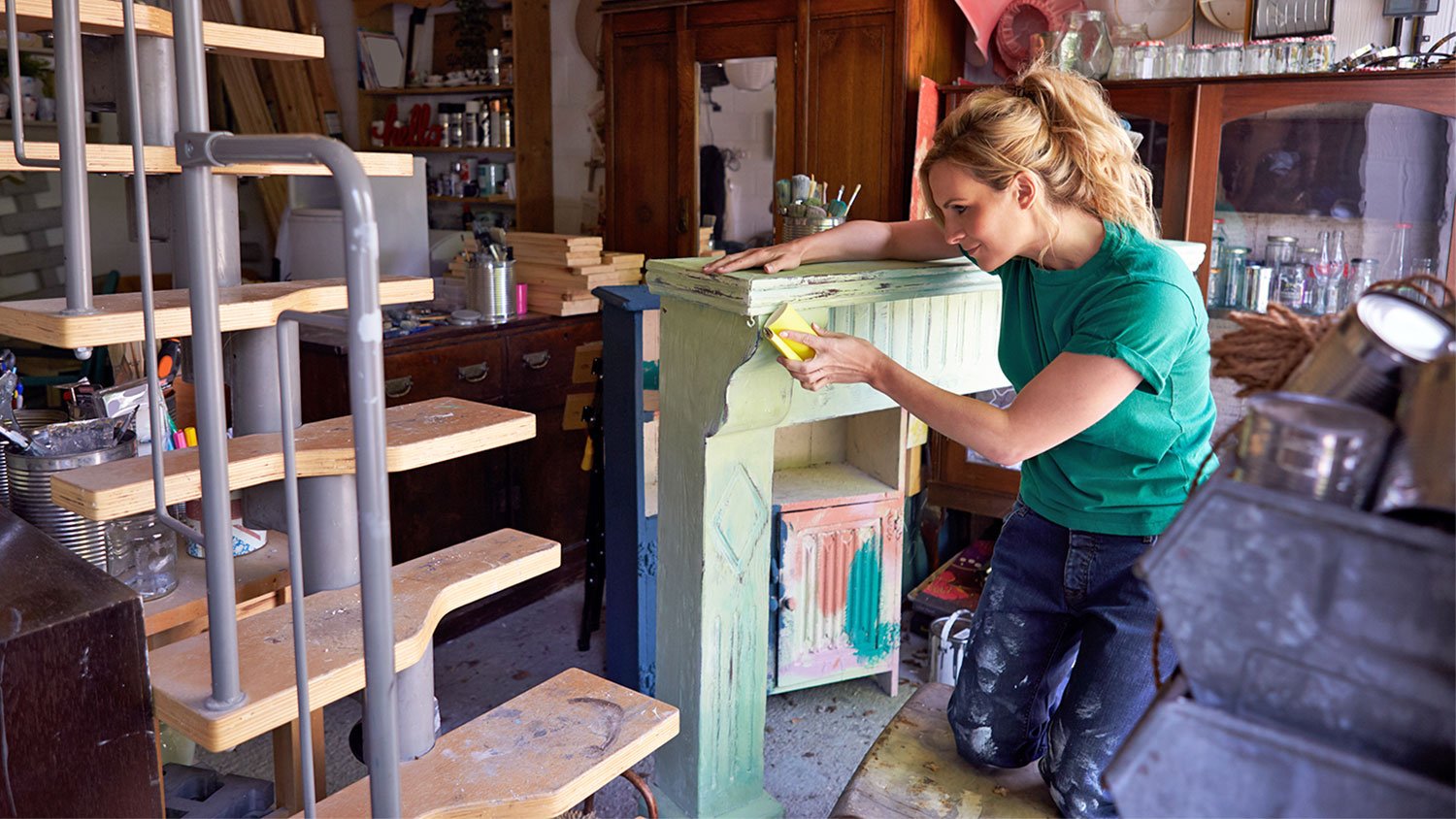How to Build a Farmhouse Table in 14 Steps
Bring your dining space to life with a rustic farmhouse table


- 17 2-by-6-inch by 8-foot wall studs
- 1 4-by-4-inch by 8-foot pine board
- 1 1-by-6-inch by 6-foot pine board
- 2 ½-inch pocket screws
- 2 ½-inch brad nails
- Tape measure
- Clamps
- Regular kreg jig
- Wood glue
- Sandpaper
While farmhouse tables are a familiar part of the recent rustic home trend, these dining tables were created by early settlers who constructed them out of reclaimed wood and passed them down for generations. The farmhouse table’s classic lines and functional structure have made them popular and widely available at furniture stores and retail shops, but you can make your own DIY version for a fraction of the cost.
By following our step-by-step guide, you’ll have a farmhouse table that looks as good as the ones you see in magazines without the hefty price tag, shipping fees, and waitlists. Keep in mind that this project has a high difficulty level and requires using potentially dangerous tools, so ensure you have the necessary skills and experience before diving into the building process.
Preparing to Build a Farmhouse Table

Before you put your power tools to use, the proper measuring can help set your project up for success. Purchasing all of your materials ahead of time, instead of as you go, will also ensure you have exactly what you need (and then some) to avoid multiple trips to the hardware store.
Measure Your Space
Before you hit the lumber yard, it helps to measure the area where you’re planning to put the table, such as a designated dining room or an eat-in kitchen. Once you measure the length and width of the room, subtract six feet from the length and width to allow for a three-foot clearance on each side. You’ll need enough space to fit an 84-by-40-inch table that seats six but can accommodate 10 people if necessary.
Purchase the Materials
If you own the necessary cutting equipment, such as a miter saw and a kreg jig, the remaining materials can be found at a lumber yard or a home improvement store. You can have your boards cut to size at a local hardware store, but it helps to have cutting tools at home in case you need to make adjustments. In the DIY world, there are almost always adjustments.
14 Steps to Build a Farmhouse Table
Follow these steps to create your own farmhouse table.
Rip the Pine Boards
If you want a higher-end look, kick off this project by ripping the rounded edges off of the 2-by-6-inch boards. If you can, rip all the boards at the same time to ensure the cuts are consistent at 5 inches wide. Rip enough off one side of the boards to remove only the rounded edges, and then rip the other rounded side off the 2-by-6-inch boards with your table saw set at 5 inches.
Make the Table Legs
 Photo: SeventyFour / iStock / Getty Images
Photo: SeventyFour / iStock / Getty ImagesTo make the four table legs, take two flattened 2-by-6-inch boards and cut them into eight 21 3/4-inch pieces. Next, drill 1 1/2-inch pocket holes at one end of each of the eight pieces. In this step, you will take two pieces at a time and laminate them together to create four legs. When laminating, ensure the pocket holes at the outer edges face outward.
Use plenty of wood glue and clamp the boards together so that the outer edges are flush. Secure the pieces with 2 ½-inch brad nails and repeat for the remaining legs.
Form Upper and Lower Base
Next, you’ll make two identical bases: One that sits on the floor and another that supports the tabletop. To create the first base, cut your 2-by-6-inch boards to create two pieces at 30 inches in length each and another piece that measures 50 1/2 inches long. These three boards will form an “I,” with the 50 1/2-inch piece centered between the other boards.
Attach the middle piece to the other boards with wood glue and 2 1/2-inch pocket screws through pocket holes. Repeat this step to create the second base.
Cut Boards and Add Pieces to Bases
Use your miter saw to cut two 2-by-6-inch boards to 68 1/2 inches long with the saw set at a 45-degree angle. Make these cuts at both ends of each board. Next, cut eight 2-by-6-inch boards to 12 inches long with the miter saw at a 45-degree angle. These cuts will only be made on one end of each board.
Secure the 68 1/2-inch boards to the top of the center of each assembly with wood glue and 2 1/2-inch brad nails. The boards will hang over the edge by about 4 inches on each side. Then, attach the 12-inch-long pieces on either side of the 68 1/2-inch boards with wood glue and brad nails. These pieces will sit about ½ inch short of the boards they sit on top of.
Attach Blocks
Flip each base assembly upside down. Then, cut two 4 1/2-inch by 5-inch blocks and attach them to the underside of the extensions with wood glue and brad nails.
Add Foot Pads
Cut seven 1-by-6-inch boards into 5-inch-long pieces. With the lower base still flipped over, use wood glue and brad nails to attach the foot pads to the bottom of the base. Place one in the center of the longest board (the middle of the “I”) and one at the ends of each 30-inch board and two on the extensions.
Build Leg Assemblies
The next step is to unclamp your table legs and cut two 4-by-4-inch boards to 7 inches long. Glue and clamp two legs to a 4-by-4-inch piece, ensuring the pocket holes of the legs are facing the inside of the upper left piece and the outside of the lower right piece. Then, screw 4-inch SPAX screws into the outside and inside holes and into the inner 4-by-4-inch piece. Repeat this step with the second set of legs.
Secure Table Legs to the Base
 Photo: very_ulissa / Adobe Stock
Photo: very_ulissa / Adobe StockNow that you’ve joined the table legs together, it’s time to add them to the lower base of the table. Take each set of table legs and position them so that they are perpendicular to the lower base assembly. There should be about 6 1/2 inches between the outside of each leg and the edge of the board. With the 4-by-4-inch brace closest to the base assembly, secure the table legs with wood glue and 2 1/2-inch pocket screws.
Attach the Upper Assembly
Using wood glue and 2 1/2-inch pocket screws, attach the upper assembly piece to each set of upright legs. The table leg assemblies should be perpendicular to the upper base before putting the screws in place.
Cut Angle Braces
To start this step, cut four 4-by-4-inch boards to 10 inches long. Set your miter saw to 31.6 degrees and place a 4-by-4-inch board with its end up against the miter saw fence. The board should sit perpendicular to the fence. Grip the 4-by-4-inch board and apply pressure downward, then slowly cut through it.
Release the saw trigger and wait until the blade has completely stopped before removing the board. Next, set the same board with the long end against the miter saw fence to cut the other angle. Repeat this step for the remaining wedge pieces.
Add the Wedges
Center the 4-by-4-inch wedges on the 2-by-6-inch feet, with the longest side of the wedge facing outward. Use wood glue to secure the wedges to the feet, then hammer your 2 1/2-inch brad nails into each piece until the wedges are properly in place. Once you’re happy with the result, repeat this process with the remaining wedges.
Assemble the Tabletop
Now it’s time to put your tabletop together. Drill 1 1/2-inch pocket holes into the edges of the 74-inch boards, and then attach each board edge-to-edge using wood glue and 2 1/2-inch pocket screws. Next, cut the end boards so that they fit flush with the outside edges of the 74-inch boards.
Your end boards should measure about 40 inches long and 5 inches wide. Secure them to the 74-inch boards with wood glue and 2 1/2-inch pocket screws.
Attach the Table Legs
Place the tabletop face down on a flat surface with the pocket holes facing up. For this step, you’ll need another set of hands to help you assemble the legs upside down and attach them to the bottom of the tabletop. Together, center the legs by leaving 5 inches on each side lengthwise and 7 1/4 inches from the width of the top. Secure the legs with the 4-inch SPAX wood screws and voilà—you have a functioning farmhouse table!
Apply Finishing Touches
 Photo: Tatomm / iStock / Getty Images
Photo: Tatomm / iStock / Getty ImagesOnce your table is in one piece, you can apply the finishing touches of your choice, including paint or a specific stain and sealant. Whether you choose to paint or stain the table, you’ll need to sand the wood first using an orbital sander. If you’re painting, apply a coat of primer after sanding to ensure the first coat of paint goes on smoothly.
When selecting a stain, it helps to buy a few options and try them out on a spare piece of wood before applying one to the entire table. When you’ve chosen the final color, pour the stain on the wood and use a brush or cloth to evenly spread it on the surface, moving along the grain of the wood. When the stain is dry and you’re happy with the color, apply a sealant to protect it from wear and tear.
Cost to Build a Farmhouse Table Yourself
If you already own a miter saw or kreg jig, this project leans more toward the lower end of the price range. However, the purchase of new tools will tip the total cost closer to $200 or more, depending on if you buy new or used tools. If you don’t want to purchase brand-new equipment, some hardware stores make cutting tools available to rent for an allotted time period. However, this is a cost-saving option so long as you finish the project within the rental time frame.
DIY Farmhouse Table vs. Hiring a Pro
In some cases, a DIY project sounds appealing but isn’t worth the time or effort it takes to complete it well. Plus, this project requires using potentially dangerous tools that could be risky for unskilled homeowners to use.
If that’s the case, you may be better off hiring a custom furniture builder who can rely on years of experience and specific skills to make the table of your dreams. It may cost more than a DIY, but it will save you time and stress in the long run.













